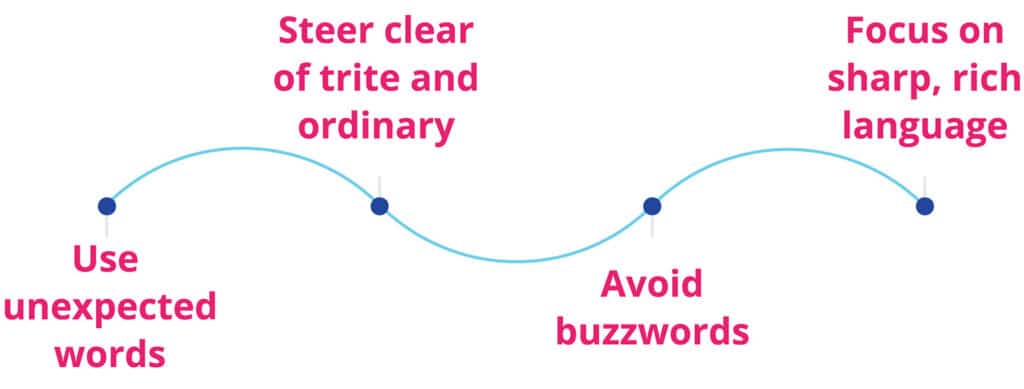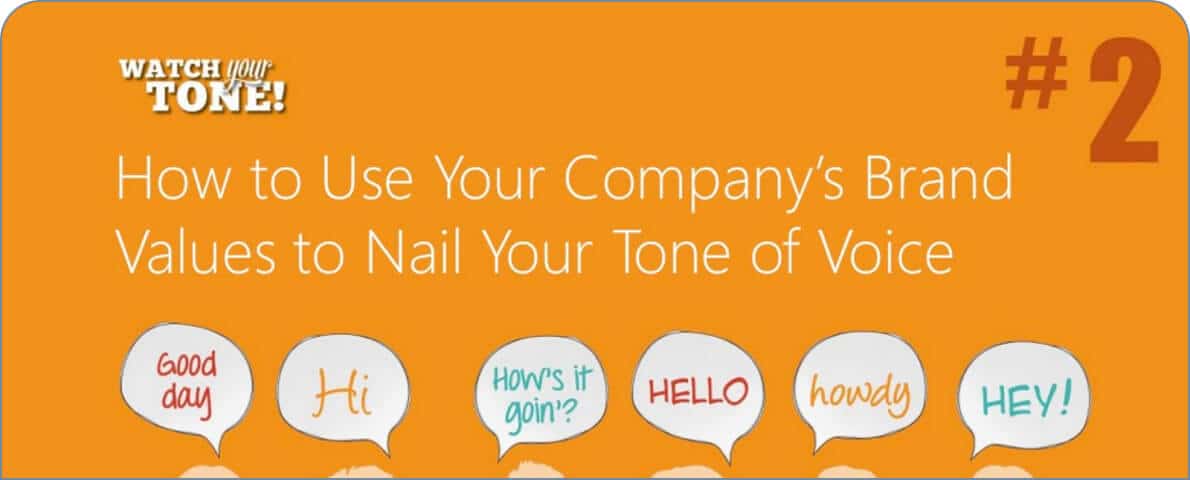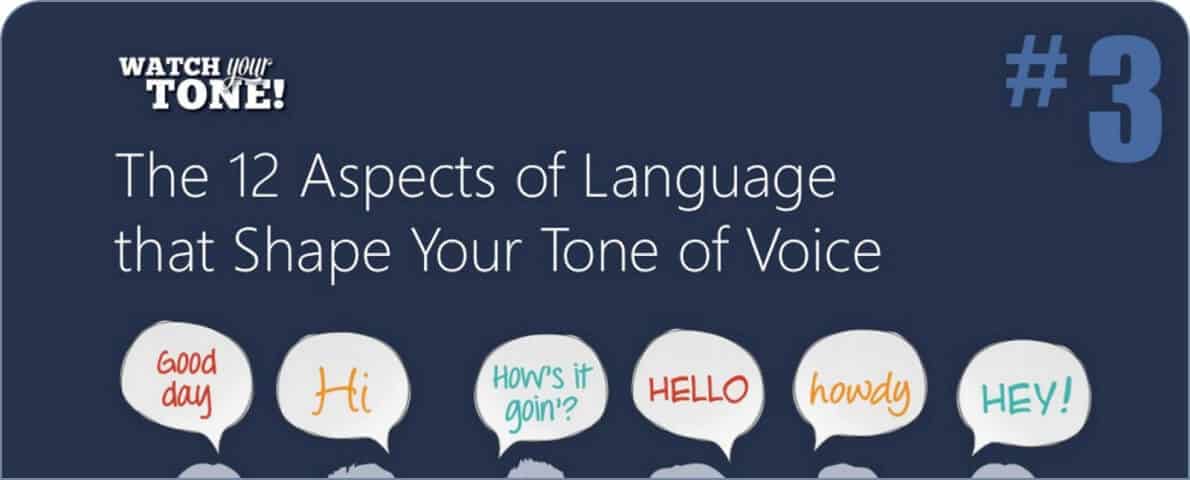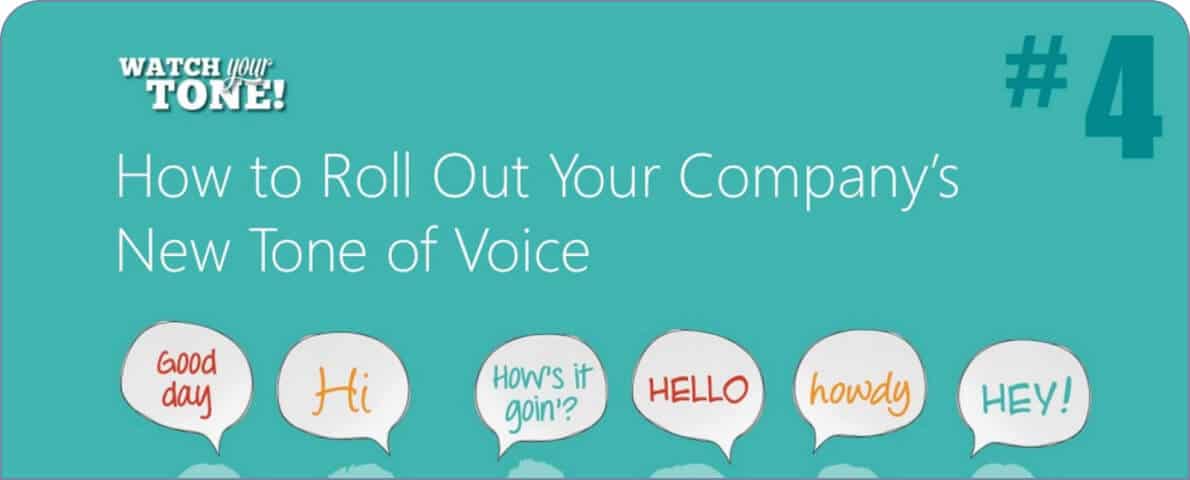How to Craft a Compelling Tone of Voice for Your Company
We’ve written about what tone of voice is and why it’s important before. Here, we’re giving you the resources you’ll need to actually develop yours.

Pressed for time? The SlideShares at the bottom of this page condense much of the information you’ll need into quick and easily digestible bites. Want more detail? Our tone of voice workbook has everything you need.
Want to develop your company’s tone of voice? The first step is to assess your current tone of voice, and how it’s working for — or against — your business. If you’ve never thought about tone of voice before, chances are your current tone is one of two things. It could be the standard-issue tone used by most B2B companies: serious, heavy on features, sprinkled with a little jargon. On the other hand, if you have lots of writers, it could be a patchwork of styles, with everyone doing what feels right.
One way to get a quick sense for your tone of voice is to read some of your content out loud — maybe your homepage or a key sales letter. Now picture the person who’s speaking. Is he a vivacious live wire or an uptight buzz killer? Does she intrigue you, irritate you, or just bore you? Would you want to work with that person? Sometimes, people are great at speaking to customers, but overthink it when they sit down to write. Reading out loud helps them realize when they’ve done that.
You can also try recreating the “Pepsi challenge” by comparing your content with a direct competitor’s. Take some content from each company, delete the brand names, read them out loud, and see whether people can guess who’s talking. If they can’t, that’s a sign your tone isn’t making you stand out.
Tone of voice is a force multiplier. Present your content in a flat voice and you might make your budget back. Use a breakthrough voice that draws people in and you’re maximizing your ROI.
– Doug Kessler, Co-founder and Creative Director, Velocity Partners
It All Begins with Your Brand
Tone of voice can’t happen in a vacuum. It has to begin with your brand values. Maybe you’ve already done some work to define your brand values by, for example, developing a brand positioning statement, a vision or mission statement, brand pillars, or some other document. It doesn’t matter what you created, just that you thought seriously about what your brand is all about.

If you want to work “outside in,” survey some other brands in your market. How do they position themselves? What are their key messages? And how do they use language to get them across?
Surveying your sector in this way has benefits. It reveals the universal values that all companies in your sector must have, just to play in the game. However, there may be other values that everyone uses out of habit or groupthink — even though they’re not essential. These are your opportunities to do something different. There could be an opportunity for you to establish a distinctive voice, as long as you can do so without compromising your industry’s universal values.
With the “inside out” approach, you start at the core of your business and build outward to values, then on to tone. To get started, consider questions like:

Brainstorming answers to these questions should generate useful ideas. If the well runs dry, you can always mix things up by using analogies or metaphors: If your company were a person, what would it be like to talk to, or hang out with? What car, film character, restaurant, or clothing brand would it be?
Developing a tone of voice can’t just be a box-ticking exercise. You need to anchor your tone in your brand. There has to be a commercial imperative, whether that’s increasing revenues or something else. And you have to know how you’ll measure success.
– Liz Doig, Brand Language Consultant, Wordtree
A Simple Framework for Brand Values
How you capture your findings is up to you. One simple method is to boil everything down to three one-word values that reflect the essence of your brand. Those values need to be distinct, but still complementary — that is, not synonymous, but not total opposites either.
Don’t be afraid of using unexpected words — the sort of words you don’t normally hear in B2B marketing. If the values are unique, the words to express them should be too. Remember, you’re looking for the things that make you different — not things that everyone in your market can lay claim to.
Don’t fall into the trap of choosing trite, non-differentiating factors such as “friendly,” “honest,” or “reliable,” as brand values. Those attributes are the least you would expect from any provider. They may be important to your service, but they won’t help you create a distinctive tone of voice.
Also, avoid B2B buzzwords like “dynamic” or “proactive.” They’re clichés, so if you’re looking to be different, they put you at a disadvantage right from the start. Plus, they’re vague at best and meaningless at worst. Instead, search for sharper, richer, more colorful words that get closer to who you really are, and how you really work.
As you develop your values, you build a shared understanding of what they mean. Then you can see more clearly how they’ll translate into writing style. And later on, when you’re putting your tone of voice into practice, it will be much easier to work out whether things you’ve written are in line with your tone.
Once you have your brand values nailed down, consider how they’ll translate into writing style. For some more experienced writers, the values alone might be enough of a guide. But if you want everyone to understand how to articulate them, you’ll need to build a bridge between your values and your tone. That means thinking about how each value translates into writing style.

In the same way as you made your brand values specific, make your tone specific. Don’t waste time writing generic or obvious guidance, or saying the same thing over and over. Remember, you’re looking for points of difference.
One mistake is to stay too high level. Businesses choose a set of core values and say ‘go and write like that.’ It gives you some direction, but if one of your values is ‘confidence,’ what does that mean? You can be confident in a down-to-earth, relaxed way, or in an authoritative, confrontational way. Unless you can define the difference and show people how to do it, you won’t get far.
– Neil Taylor, Managing Partner, The Writer
Defining Your Tone of Voice
To help you define your tone of voice, let’s look at different types of tone and explore different aspects of writing style. One way to think about tone of voice is as a set of sliding controls, like a graphic equalizer. By moving the controls to one extreme or another, you change one aspect of the tone. Here are a few examples:

| Low reading grade level (age 9) We can fix all your computers and keep them working. |
High reading grade level (age 17) We offer hands-on repair and maintenance services for your entire computing infrastructure. |

| Formal Established in 1878, we remain a family firm with a proud heritage of excellent service and unstinting attention to detail. |
Informal We’ve been around a long time, but we still care about going the extra mile and getting all those little things just right. |

| Punchy Big, boxy, and unbreakable. That’s what people said they wanted from a carrying case. So that’s how we built ours. |
Flowing When you’re looking for the reassurance that your valuable machinery will be safely protected at all times, our solidly built carrying cases are the only realistic option. |

| Warm Are you sinking under the weight of your admin? Well, stop worrying. Our temps are here to give you all the help you need. |
Detached AdminCo’s secretarial services have been designed to optimize every aspect of clients’ day-to-day operations for efficiency and effectiveness. |
There are, of course, many other examples. The question becomes, how does tone of voice translate into hands-on writing style? Here are 12 things to think about as you’re writing:
- Word length As children, we learn shorter words first, longer ones later. So if you want to be clearly understood by readers of all reading levels, use shorter words. When it comes to tone, short words are simple and direct, while longer ones suggest sophistication and nuance. Shorter words tend to be punchier and harder, while longer words can give a softer, more relaxed effect.
- Sentence length Shorter sentences give a concise style, while longer ones are more sedate. A good guide is that you should be able to read the whole sentence out loud in a single breath.
- Tempo Using shorter average sentence length is good, but the important word is average. To keep readers interested, vary the length of sentences and paragraphs to give an organic, varied rhythm with its own ebbs and flows.
- Pronouns Pronouns are words that stand in place of the names of people or things. Your choice of pronouns can have a big effect on your tone. For example, when writing about your company, you can use the first person (“we”) or the third person (“Acme Corp”). The first person is more immediate, positioning yourself as a group of people, while the third person is much more detached and abstract, with less clarity as to who is speaking.
When writing for an audience, you can use the second person (“you”) or the third (“customers,” “suppliers”). The second person is direct and engaging, while the third is more distanced. - Conciseness Conciseness is the ratio of ideas to words. The fewer words you use to convey an idea, the more concise you are. On a practical level, more concise is better. Getting to the point saves time and therefore money. But if you want to adopt a more flowing, rambling, or descriptive tone, you’ll need some “extra” words to achieve the laid-back feel you’re going for.
- Jargon Jargon is specialized language used in a particular professional domain such as law, finance, and engineering, among others. There’s a simple guideline to remember about jargon: bad jargon hides the truth and bamboozles people, good jargon signals that you're part of a community.
- Buzzwords Buzzwords are jargon terms that have the attraction of novelty. Some fields, particularly in the tech industry, generate a lot of buzzwords because they need to name innovations (e.g., “millennials,” “big data,” “Internet of things,” etc.).
The same caution applies to buzzwords as to jargon: only use them if you know the audience will understand. Also, remember that today’s hot buzzword is tomorrow’s embarrassing anachronism. Using buzzwords plants a time bomb under your content, guaranteeing it will sound dated in the future. - Clichés Clichés are words and phrases that have become worn out through overuse. In B2B, words such as “solution,” “proactive,” and “leverage” were once new and fresh, but have now become clichéd. Using clichés will probably make your tone sound stale and dull. There may be times when you need to meet readers where they are by using a cliché you know they’ll respond to, but you could pay a high price if you wind up sounding like everyone else.
- Contractions Contractions are formed of two words combined into one, such as “you’re,” “don’t,” or “it’s.” Most people use contractions all the time when they talk, except in the most formal situations. So using them in writing makes your tone informal, relaxed, and accessible, and gives readers a strong sense of being in a conversation.
- Colloquialisms Colloquial language is the language of everyday casual speech — the way we talk when nobody’s watching. It’s a flexible term, because the definition of “casual” varies from speaker to speaker, and from culture to culture. Colloquial language is likely to use contractions (see above) and may also include slang, or even profanity. But colloquial doesn’t necessarily mean simple. Writing colloquially doesn’t mean you can’t cover technical features or concepts. It just means you adopt the tone of an expert chatting to a non-expert.
- Obscure words Using obscure or unusual words has a similar effect as using jargon — you’re gambling on if the audience will understand what you’re saying. However, you might want to drop one in from time to time to suggest refinement or a certain type of heritage.
- Mistakes and rule-breaking Technical problems that can creep into your writing include easily confused words, misspellings, and grammar errors. Most people would agree that using the wrong word, or spelling the right word incorrectly, is undesirable in business writing. Unless it’s part of a deliberate creative strategy, a mistake can only harm your chances of communicating well.
On grammar, the picture is less black and white. The prescriptive view is that we should respect and obey the rules of grammar whether we agree with them or not. The descriptive view is that the right way to use language is the way people actually use it in speech and writing, not as reflected in rules created by academics.
Some grammar rules can be bent or broken. For example, starting a sentence with “and” or “but,” or ending one with a preposition like “on,” may not be strictly correct, but most people do it when they talk. So you might want to do the same if your goal is to achieve a casual or colloquial tone.
Mixing It Up
One of the pitfalls in defining tone of voice is being too rigid. Just like a person, your brand needs to take a different tone in different situations. Even though you might use different language with your family than you would with your boss, you’d still be the same person in both cases.
In the same way, your corporate tone might have to adapt to different situations, but keep the same basic character. For example, an email offering a customer a special discount has to sound different from one responding to a complaint.
Realistic or Aspirational?
Your tone of voice has to be real — something that everyone can believe in. That’s why it’s so important to begin with brand values. If you don’t, you risk creating a tone that’s out of step with your company culture and the way you actually work, and people will feel uneasy or embarrassed about using it.
However, changing your tone of voice can also be a catalyst for change. It all depends on whether your new tone shines a light on the right way forward, or leads you astray.
For example, if firms in your industry tend to over-promise and under-deliver, you might aspire to be “believable.” But how would you write so that people believe? By using concrete, factual language backed up with third-party authorities, like a journalist for a reputable trade magazine.
Into the Future
OK, we’ve come a long way on our tone of voice journey. As we’ve seen, tone of voice isn’t a project, it’s a process — and that process never really ends. And then there’s the whole matter of rolling your new tone of voice out (more details on this in our eBook and SlideShares below).
In addition to making sure people continue to use your tone, you need to revisit it from time to time to make sure it’s still relevant. Have things moved on in your industry? Have you moved on as a company? Or have new trends in tone of voice emerged? Just as you need to get your tone right at the outset, so you need to make sure it stays right into the future.
If you want to learn how content governance can help your enterprise maintain a consistent tone of voice, learn more about Acrolinx here.
Watch Your Tone! Second Edition
The Ultimate Guide to Developing
Your Company's Tone of Voice
Acrolinx & Adobe: A complete creative solution for enterprise content
Our solutions connected together help organizations create better brand-aligned content at scale, right from the start.





